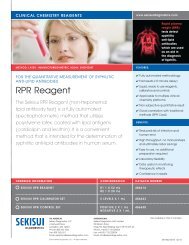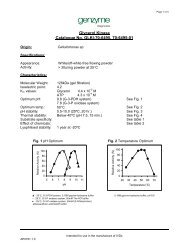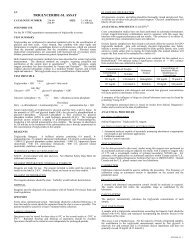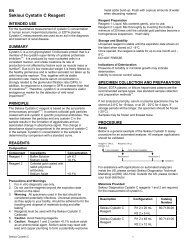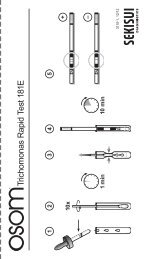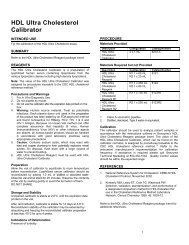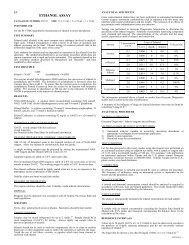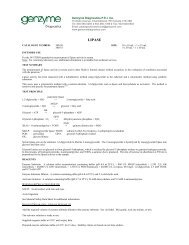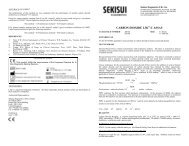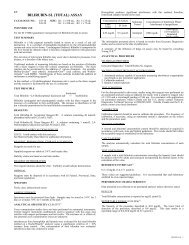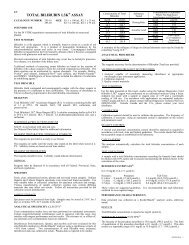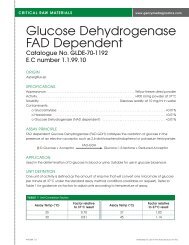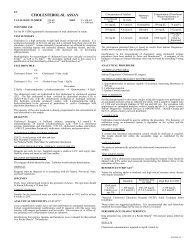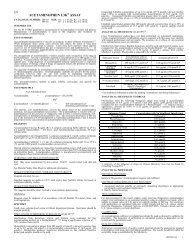HDL Ultra Cholesterol Reagent - Sekisui Diagnostics
HDL Ultra Cholesterol Reagent - Sekisui Diagnostics
HDL Ultra Cholesterol Reagent - Sekisui Diagnostics
You also want an ePaper? Increase the reach of your titles
YUMPU automatically turns print PDFs into web optimized ePapers that Google loves.
<strong>HDL</strong> <strong>Ultra</strong> <strong>Cholesterol</strong> <strong>Reagent</strong><br />
CATALOGUE NUMBER: 6121 SIZE: R1 1 x 60 mL<br />
R2 1 x 20 mL<br />
6122 R1 1 x 250 mL<br />
R2 1 x 80 mL<br />
INTENDED USE<br />
For the quantitative measurement of high-density lipoprotein<br />
cholesterol (<strong>HDL</strong>-C) concentration in human serum or plasma.<br />
TEST SUMMARY<br />
Plasma lipoproteins are spherical particles containing varying<br />
amounts of cholesterol, triglycerides, phospholipids and proteins.<br />
The phospholipid, free cholesterol and protein constitute the outer<br />
surface of the lipoprotein particle, while the inner core contains<br />
mostly esterified cholesterol and triglyceride. These particles serve<br />
to solubilize and transport cholesterol and triglyceride in the<br />
bloodstream.<br />
The relative proportions of protein and lipid determine the density of<br />
these lipoproteins and provide a basis on which to begin their<br />
classification. 1 The classes are: chylomicron, very-low-density<br />
lipoprotein (VLDL), low-density lipoprotein (LDL) and high-density<br />
lipoprotein (<strong>HDL</strong>). Numerous clinical studies have shown that the<br />
different lipoprotein classes have very distinct and varied effects on<br />
coronary heart disease risk. 2<br />
The principle role of <strong>HDL</strong> in lipid metabolism is the uptake and<br />
transport of cholesterol from peripheral tissues to the liver through a<br />
process known as reverse cholesterol transport (a proposed<br />
cardioprotective mechanism). 3 Low <strong>HDL</strong>-C levels are strongly<br />
associated with an increased risk of coronary heart disease and<br />
coronary artery disease. 4-9 Hence, the determination of serum <strong>HDL</strong>-<br />
C is a useful tool in identifying high-risk patients. The Adult<br />
Treatment Panel of the National <strong>Cholesterol</strong> Education Program<br />
(NCEP) recommends that in all adults 20 years of age and over, a<br />
fasting lipoprotein profile (total cholesterol, LDL cholesterol, <strong>HDL</strong><br />
cholesterol and triglyceride) should be obtained once every five<br />
years to screen for coronary heart disease risk. 10<br />
The reference method for the quantification of <strong>HDL</strong>-C combines<br />
ultracentrifugation and chemical precipitation to separate <strong>HDL</strong> from<br />
other lipoproteins, followed by cholesterol measurement by the<br />
Abell-Kendall method. 11 The first routine methods widely utilized<br />
by laboratories involved selective precipitation and removal of LDL<br />
and VLDL, followed by the enzymatic measurement of <strong>HDL</strong>-C in<br />
the supernatant fraction. 11 Since these methods require off-line<br />
pretreatment and separation steps the assay procedures cannot be<br />
fully automated. As a result, routine determination of <strong>HDL</strong>-C has<br />
suffered from long handling times and poor reproducibility.<br />
TEST PRINCIPLE<br />
The <strong>HDL</strong> <strong>Ultra</strong> <strong>Cholesterol</strong> assay is a homogeneous method for<br />
directly measuring <strong>HDL</strong>-C concentrations in serum or plasma<br />
without the need for any off-line pretreatment or centrifugation<br />
steps.<br />
The method is in a two reagent format and depends on the properties<br />
of a unique detergent, as illustrated. This method is based on<br />
accelerating the reaction of cholesterol oxidase (CO) with non-<strong>HDL</strong><br />
unesterified cholesterol and dissolving <strong>HDL</strong> selectively using a<br />
specific detergent. In the first reagent, non-<strong>HDL</strong> unesterified<br />
cholesterol is subject to an enzyme reaction and the peroxide<br />
generated is consumed by a peroxidase reaction with DSBmT<br />
yielding a colorless product. The second reagent consists of a<br />
detergent capable of solubilizing <strong>HDL</strong> specifically, cholesterol<br />
esterase (CE) and chromogenic coupler to develop color for the<br />
quantitative determination of <strong>HDL</strong>-C. This may be referred to as the<br />
Accelerator Selective Detergent methodology.<br />
Accelerator Selective Detergent Methodology<br />
Accelerator + CO<br />
<strong>HDL</strong>, LDL, VLDL,<br />
Chylomicrons<br />
DSBmT + Peroxidase<br />
<strong>HDL</strong> Specific Detergent<br />
Non-Reactive LDL,<br />
VLDL, Chylomicrons<br />
<strong>HDL</strong><br />
<strong>HDL</strong> Disrupted<br />
CE<br />
<strong>HDL</strong> <strong>Cholesterol</strong> ∆ 4 Cholesterone + H 2 O 2<br />
CO<br />
H 2 0 2 + DSBmT + 4-AAP<br />
Color Development<br />
Peroxidase<br />
REAGENTS<br />
Composition of <strong>Reagent</strong>s:<br />
Component Ingredients Concentration<br />
<strong>Reagent</strong> 1<br />
<strong>Reagent</strong> 2<br />
Buffer<br />
<strong>Cholesterol</strong> oxidase<br />
(Fr: E. Coli)<br />
Peroxidase<br />
(Fr: Horseradish)<br />
N,N-bis(4-sulphobutyl)-mtoluidine-disodium(DSBmT)<br />
Accelerator<br />
Preservative<br />
Ascorbic Oxidase<br />
(Fr: Curcubita sp.)<br />
Buffer<br />
<strong>Cholesterol</strong> esterase (Fr:<br />
Pseudomonas sp.)<br />
4-Aminoantipyrine (4-AAP)<br />
Detergent<br />
Preservative<br />
WARNINGS AND PRECAUTIONS FOR USE<br />
DISPOSAL<br />
<strong>Reagent</strong>s must be disposed of in accordance with all Federal,<br />
Provincial, State and local regulations.<br />
SPECIMEN<br />
Serum, EDTA-treated or heparinized plasma drawn from the patient<br />
after a 12 – 14 hour fast are the required specimens.<br />
Serum: Collect whole blood by venipuncture and allow to clot.<br />
Centrifuge and remove the serum as soon as possible after collection<br />
(within 3 hours). 11<br />
Plasma: Specimens may be collected in EDTA or lithium or sodium<br />
heparin. Centrifuge and remove the plasma as soon as possible after<br />
collection (within 3 hours). 11<br />
Serum or plasma should not remain at 15-30°C longer than 14 hours.<br />
If assays are not completed within 14 hours, serum or plasma should<br />
be stored at 2-8°C for up to 1 week. If specimens need to be stored<br />
for more than 1 week, they may be preserved at less than -70°C for<br />
up to 3 months. Samples may be frozen once. Refer to NCCLS<br />
Document H18-A for further instructions on specimen collection,<br />
handling, and storage.<br />
ANALYTICAL SPECIFICITY<br />
All interference studies were conducted according to a modified<br />
NCCLS guideline No. EP7 for interference testing in clinical<br />
chemistry. 13<br />
Substances Tested<br />
Bilirubin Conjugated<br />
Bilirubin Total<br />
Hemoglobin<br />
Ascorbic Acid<br />
Lipemia using<br />
Intralipid ®<br />
Gamma-globulins<br />
Concentration with no significant<br />
(±10%) interference<br />
60 mg/dL<br />
60 mg/dL<br />
1000 mg/dL<br />
100 mg/dL<br />
1800 mg/dL<br />
5000 mg/dL<br />
The information presented above is based on results from <strong>Sekisui</strong><br />
<strong>Diagnostics</strong>’ studies and is current at the date of publication.<br />
Refer to the work of Young for a review of drug effects on serum<br />
<strong>HDL</strong> cholesterol levels. 14<br />
ANALYTICAL PROCEDURE<br />
MATERIALS PROVIDED<br />
Both the <strong>HDL</strong> <strong>Ultra</strong> <strong>Cholesterol</strong> <strong>Reagent</strong> 1 and <strong>Reagent</strong> 2 are<br />
required for the measurement of <strong>HDL</strong> cholesterol.<br />
Description Configuration Catalog Number<br />
<strong>HDL</strong> <strong>Ultra</strong> R1 1 x 60 mL 6121<br />
<strong>Cholesterol</strong><br />
<strong>Reagent</strong><br />
R2 1 x 20 mL<br />
<strong>HDL</strong> <strong>Ultra</strong><br />
<strong>Cholesterol</strong><br />
<strong>Reagent</strong><br />
R1 1 x 250 mL<br />
R2 1 x 80 mL<br />
6122<br />
MATERIALS REQUIRED (BUT NOT PROVIDED)<br />
Description Configuration Catalog Number<br />
<strong>HDL</strong> <strong>Ultra</strong> <strong>Cholesterol</strong> 3 x 1 mL 6272-3<br />
Calibrator<br />
1. <strong>HDL</strong> cholesterol control sera or quality control material (See<br />
“Quality Control Procedures”).<br />
2. Automated clinical chemistry<br />
accommodating two-reagent assays.<br />
analyzer capable of<br />
3. Class A volumetric pipettes.<br />
4. Distilled, deionized, Type II water or equivalent.<br />
TEST CONDITION<br />
Below is a general example of the <strong>HDL</strong> <strong>Ultra</strong> <strong>Cholesterol</strong> assay<br />
procedure for an automated analyzer.<br />
Sample<br />
3µL<br />
<strong>Reagent</strong> 2<br />
100µL<br />
37C<br />
5 min<br />
<strong>HDL</strong>-C<br />
Result<br />
For assistance with applications on automated analyzers, please<br />
contact <strong>Sekisui</strong> <strong>Diagnostics</strong> Technical Services at 1-800-565-0265.<br />
Outside Canada and the U.S., please contact your local distributor.<br />
CALIBRATION<br />
The <strong>HDL</strong> <strong>Ultra</strong> <strong>Cholesterol</strong> Calibrator is required for calibration.<br />
The value of the <strong>HDL</strong> <strong>Ultra</strong> <strong>Cholesterol</strong> Calibrator was assigned by<br />
procedures traceable to the CDC <strong>HDL</strong> cholesterol reference<br />
method. 20, 21 Calibration materials have concentrations at<br />
approximately the medical decision level. Refer to the <strong>HDL</strong> <strong>Ultra</strong><br />
<strong>Cholesterol</strong> Calibrator kit package insert for instructions. Refer to<br />
the instrument operator’s manual for analyzer specific procedures<br />
and for guidance in determining calibration frequency.<br />
Quality Control values should be within the expected range.<br />
QUALITY CONTROL<br />
Reliability of test results should be routinely monitored with control<br />
sera or quality control materials that reasonably emulate<br />
performance on patient specimens. 11 The National <strong>Cholesterol</strong><br />
Education Program (NCEP) Lipid Standardization Panel (LSP)<br />
recommends two levels of controls, one in the normal range (40-65<br />
mg/dL) and one near the concentrations for decision making (2000 mg/dL<br />
should not be diluted.<br />
7. Samples from patients of cirrhotic liver have been reported to<br />
give <strong>HDL</strong> results lower than reported from reference method. 15<br />
REFERENCE INTERVALS<br />
The following NCEP cutpoints for patient classification are used to<br />
10, 16<br />
assess the risk and management of coronary heart disease.<br />
Males: 30 - 70 mg/dL<br />
Females: 30 - 85 mg/dL<br />
PERFORMANCE CHARACTERISTICS<br />
RESULTS<br />
+<br />
+<br />
<strong>Reagent</strong> 1<br />
300µL<br />
37C<br />
5 min<br />
Measurement (absorbance<br />
difference between<br />
700nm and 600nm)<br />
Measurement (absorbance<br />
difference between<br />
700nm and 600nm)<br />
To convert from conventional units to S.I. units, multiply the<br />
conventional units by 0.0259.<br />
(IN6121-1) 2
mg/dL x 0.0259 = mmol/L <strong>HDL</strong>-<strong>Cholesterol</strong><br />
REPORTABLE RANGE<br />
Linearity studies were conducted using a cholesterol linearity<br />
verifier. Linearity samples were prepared according to the package<br />
insert instructions. The <strong>HDL</strong> <strong>Ultra</strong> <strong>Cholesterol</strong> reagent was found to<br />
be linear from 2.5 mg/dL to 200 mg/dL with a deviation from the<br />
linear line of less than or equal to 4 mg/dL or 5%. Patient samples<br />
with <strong>HDL</strong> cholesterol levels exceeding 200 mg/dL should be diluted<br />
with physiological saline before assaying. Multiply the result<br />
obtained from the manual dilution by the appropriate dilution factor.<br />
PRECISION STUDIES<br />
Within-run precision for the <strong>HDL</strong> <strong>Ultra</strong> <strong>Cholesterol</strong> method was<br />
determined using three levels of frozen pooled human serum. Each<br />
run consisted of twenty replicate samples. Within-run precision<br />
studies produced the following results on the Hitachi 911 Analyzer:<br />
Serum Pool LOW MID HIGH<br />
n 20 20 20<br />
Mean (mg/dL) 32.9 50.6 101.4<br />
Standard Deviation (mg/dL) 0.3 0.2 0.7<br />
Coefficient of Variation (%) 0.8 0.5 0.7<br />
Between-run precision was determined using three levels of frozen<br />
pooled human serum. The <strong>HDL</strong> <strong>Ultra</strong> <strong>Cholesterol</strong> assay was run in<br />
duplicate and analyzed twice per day over 10 days. Between-run<br />
precision studies produced the following results:<br />
Serum Pool LOW MID HIGH<br />
n 40 40 40<br />
Mean <strong>HDL</strong> <strong>Cholesterol</strong>(mg/dL) 32.8 50.0 100.1<br />
Standard Deviation (mg/dL) 0.4 0.7 1.1<br />
Coefficient of Variation (%) 1.3 1.5 1.1<br />
TOTAL ERROR DETERMINATION<br />
Total error 11,17,18 is a measure of the overall analytical performance<br />
of an assay, and combines both accuracy and precision. Total error is<br />
equal to the % Bias + 1.96 x the Total C.V. (CV T ). 19 The % Bias of<br />
the <strong>HDL</strong> <strong>Ultra</strong> <strong>Cholesterol</strong> assay was calculated using the linear<br />
regression formula, derived from the comparison of the <strong>HDL</strong> <strong>Ultra</strong><br />
<strong>Cholesterol</strong> method to the Designated Comparison Method for <strong>HDL</strong><br />
cholesterol shown above. 17,18 The CV is calculated as CV T = (CV B<br />
2<br />
+ CV W 2 ) 1/2 . 19 The results of the total error analysis for the <strong>HDL</strong> <strong>Ultra</strong><br />
<strong>Cholesterol</strong> assay on the Hitachi 911 Analyzer at low, medium and<br />
high <strong>HDL</strong> <strong>Cholesterol</strong> levels using samples with triglycerides
Serum Pool<br />
POL Site 1<br />
Mean (mg/dL)<br />
S.D. (mg/dL)<br />
C.V. (%)<br />
POL Site 2<br />
Mean (mg/dL)<br />
S.D. (mg/dL)<br />
C.V. (%)<br />
POL Site 3<br />
Mean (mg/dL)<br />
S.D. (mg/dL)<br />
C.V. (%)<br />
LOW<br />
60 mg/dL<br />
n=16<br />
65.3<br />
3.4<br />
5.2<br />
n=20<br />
68.2<br />
2.4<br />
3.5<br />
n=40<br />
76.2<br />
1.5<br />
2.0<br />
Note: Each site received a unique set of three serum pools.<br />
All trademarks, brands, product names and trade names are the<br />
property of their respective companies.<br />
The Americas<br />
<strong>Sekisui</strong> <strong>Diagnostics</strong> P.E.I. Inc.<br />
70 Watts Avenue<br />
Charlottetown, PE C1E 2B9<br />
Canada<br />
Phone: 800-565-0265<br />
Fax: 902-628-6504<br />
Email: questions@sekisuidiagnostics.com<br />
peidiagnostictechnical@sekisuidiagnostics.com<br />
International<br />
<strong>Sekisui</strong> <strong>Diagnostics</strong> (UK) Limited<br />
50 Gibson Drive<br />
Kings Hill, West Malling<br />
KENT, ME19 4AF, UK<br />
Email: info@sekisuidiagnostics.com<br />
www.sekisuidiagnostics.com<br />
<strong>HDL</strong> <strong>Ultra</strong> <strong>Cholesterol</strong> Réactif<br />
NUMÉRO DE CATALOGUE: 6121 TAILLE: R1 1 x 60 mL<br />
R2 1 x 20 mL<br />
6122 R1 1 x 250 mL<br />
R2 1 x 80 mL<br />
UTILISATION PRÉVUE<br />
Pour la mesure quantitative de la concentration de cholestérol des<br />
lipoprotéines à haute densité (<strong>HDL</strong>-C) dans le sérum humain ou le<br />
plasma.<br />
RÉSUMÉ DES TESTS<br />
Les lipoprotéines du plasma sont des particules sphériques<br />
contenant des quantités variables de cholestérol, de triglycérides, de<br />
phospholipides et de protéines. Les phospholipides, le cholestérol<br />
libre et la protéine constituent la surface extérieure de la particule<br />
de lipoprotéine, alors que le noyau interne contient surtout du<br />
cholestérol estérifié et des triglycérides. Ces particules servent à<br />
solubiliser et à transporter le cholestérol et les triglycérides dans le<br />
courant sanguin.<br />
Les proportions relatives de protéines et de lipides déterminent<br />
la densité de ces lipoprotéines et forment une base sur laquelle<br />
commencer leur classification. 1 Ces classes sont: chylomicron,<br />
lipoprotéine à très faible densité (VLDL), lipoprotéine à faible<br />
densité (LDL) et lipoprotéine à haute densité (<strong>HDL</strong>). De<br />
nombreuses études cliniques ont montré que les différentes classes<br />
de lipoprotéines ont des effets très distincts et variés sur le risque<br />
de coronaropathie. 2<br />
Le principal rôle du <strong>HDL</strong> dans le métabolisme des lipides est le<br />
captage et le transport du cholestérol des tissus périphériques vers<br />
le foie par un processus connu sous le nom de transport<br />
inverse du cholestérol (un mécanisme cardioprotecteur<br />
proposé). Des niveaux faibles de <strong>HDL</strong>-C sont fortement<br />
associés à un risque accru de coronaropathie et de maladie<br />
coronarienne. 4-9 D'où, la détermination du sérum <strong>HDL</strong>-C est<br />
un outil utile pour déterminer les patients à haut risque. Le Adult<br />
Treatment Panel du National <strong>Cholesterol</strong> Education program<br />
(NCEP) recommande que chez tous les adultes de 20 ans ou plus,<br />
un profil de lipoprotéine à jeun (cholestérol total, cholestérol<br />
LDL, cholestérol <strong>HDL</strong> et triglycérides) devrait être obtenu<br />
une fois tous les cinq ans pour le dépistage du risque de<br />
coronaropathie. 10<br />
La méthode de référence pour la quantification du <strong>HDL</strong>-C combine<br />
l'ultracentrifugation et la précipitation chimique pour séparer le<br />
<strong>HDL</strong> des autres lipoprotéines, suivi par une mesure du cholestérol<br />
par la Méthode Abell-Kendall. 11 Les premières méthodes de<br />
routine largement utilisées par les laboratoires impliquaient la<br />
précipitation sélective et le retrait du LDL et du VLDL, suivi par la<br />
mesure enzymatique du <strong>HDL</strong>-C dans la fraction surnageante,. 11<br />
Puisque ces méthodes nécessitaient un prétraitement hors ligne et<br />
des étapes de préparation, les procédures de dosage ne pouvaient<br />
pas être entièrement automatisées. Ainsi, la détermination de<br />
routine du <strong>HDL</strong>-C a souffert de temps de traitement longs et d'une<br />
faible reproductibilité.<br />
PRINCIPE DU TEST<br />
Le dosage <strong>HDL</strong> <strong>Ultra</strong> <strong>Cholesterol</strong> est une méthode homogène pour<br />
mesurer directement les concentrations de <strong>HDL</strong>-C dans le sérum<br />
ou le plasma sans avoir besoin d'un prétraitement hors ligne ou<br />
d'étapes de centrifugation.<br />
La méthode est dans un format à deux réactifs et dépend des<br />
propriétés d'un détergent unique, comme illustré. Cette méthode est<br />
basée sur l'accélération de la réaction du cholestérol oxydase (CO)<br />
avec un cholestérol non <strong>HDL</strong> non estérifié et sur la dissolution du<br />
<strong>HDL</strong> sélectivement en utilisant un détergent spécifique. Dans le<br />
premier réactif, le cholestérol non <strong>HDL</strong> non estérifié est soumis à<br />
une réaction enzymatique et le peroxyde généré est consumé par<br />
une réaction peroxydase avec DSBmT donnant un produit sans<br />
couleur. Le second réactif consiste en un détergent capable de<br />
solubiliser le <strong>HDL</strong> spécifiquement, un cholestérol estérase (CE)<br />
et un coupleur chromogène pour développer une couleur pour la<br />
détermination quantitative du <strong>HDL</strong>-C. On peut référer à ce<br />
processus comme étant la Méthodologie détergent sélectif et<br />
accélérateur.<br />
Méthodologie détergent sélectif et accélérateur<br />
Accélérateur + CO<br />
<strong>HDL</strong>, LDL, VLDL,<br />
LDL non réactif,<br />
Chylomicrons<br />
VLDL, Chylomicrons<br />
DSBmT + Peroxydase<br />
Détergent spécifique <strong>HDL</strong><br />
<strong>HDL</strong><br />
<strong>HDL</strong> perturbé<br />
CE<br />
<strong>HDL</strong> <strong>Cholesterol</strong> ∆ 4 Cholesterone +<br />
CO<br />
H2O2<br />
H2O2 + DSBmT + 4-AAP<br />
Peroxydase<br />
Développement de<br />
couleur<br />
(IN6121-1) 4
RÉACTIFS<br />
Composition des réactifs:<br />
Pièce Ingrédients Concentration<br />
Réactif 1 Tampon<br />
Cholestérol oxydase<br />
(Fr: E. Coli)<br />
Peroxydase<br />
(Fr: Raifort)<br />
CONDITIONS DU TEST<br />
Voici un exemple général de procédure de dosage <strong>HDL</strong> <strong>Ultra</strong><br />
<strong>Cholesterol</strong> pour un analyseur automatique.<br />
Echantillon<br />
3µL<br />
Réactif 2<br />
100µL<br />
+<br />
37C<br />
5 min<br />
<strong>HDL</strong>-C<br />
Résultat<br />
Pour tout renseignement complémentaire concernant les applications<br />
sur les automates d'analyses, contacter <strong>Sekisui</strong> <strong>Diagnostics</strong><br />
Technical Services au 1-800-565-0265. À l'extérieur du Canada et<br />
des États-Unis, veuillez prendre contact avec votre distributeur local.<br />
ÉTALONNAGE<br />
Le <strong>HDL</strong> <strong>Ultra</strong> <strong>Cholesterol</strong> Calibrator est nécessaire pour la<br />
calibration. La valeur du <strong>HDL</strong> <strong>Ultra</strong> <strong>Cholesterol</strong> Calibrator a<br />
été assignée par les procédures traçables de la méthode de<br />
référence du cholestérol <strong>HDL</strong> du CDC. 20,21 Les matériaux de<br />
calibration ont des concentrations à environ le niveau de<br />
décision médicale. Veuillez vous référer à la notice de l'ensemble<br />
de <strong>HDL</strong> <strong>Ultra</strong> <strong>Cholesterol</strong> Calibrator pour les instructions.<br />
Consulter le manuel d'utilisation de l'instrument pour les<br />
procédures spécifiques de l'automate d'analyses et les directives<br />
de calcul de la fréquence de calibration.<br />
Les valeurs de contrôle de qualité devraient se trouver dans les<br />
limites de la fourchette prévue.<br />
CONTRÔLE DE LA QUALITÉ<br />
La fiabilité des résultats de test devrait être surveillée de façon<br />
routinière avec un sérum de contrôle ou des matériaux de contrôle<br />
de qualité qui imitent raisonnablement la performance des<br />
échantillons de patients. 11 Le profil de normalisation des lipides<br />
du National <strong>Cholesterol</strong> Education Program (NCEP)<br />
recommande deux niveaux de contrôle, un dans la plage normale<br />
(40-65 mg/dL) et un près des concentrations pour la prise de<br />
décision (2000 mg/dL ne devraient pas être<br />
dilués.<br />
7. On rapporte que les échantillons de patients avec un foie<br />
cirrhotique donnent des résultats <strong>HDL</strong> plus faibles que ceux<br />
selon la méthode de référence. 15<br />
INTERVALLES DE RÉFÉRENCE<br />
Mesure (difference<br />
d’absorbance entre<br />
700nm et 600nm)<br />
Les seuils suivant par le NCEP pour la classification de patient sont<br />
utilisés pour évaluer le risque et la gestion de la coronaropathie. 10,16<br />
Hommes: 30 - 70 mg/dL<br />
Femmes: 30 - 85 mg/dL<br />
CARACTÉRISTIQUES LIÉES AU COMPORTEMENT<br />
RÉSULTATS<br />
Pour convertir des unités conventionnelles aux unités SI, multiplier<br />
les unités conventionnelles par 0,0259.<br />
mg/dL x 0,0259 = mmol/L de cholestérol <strong>HDL</strong><br />
INTERVALLE DE SIGNALEMENT<br />
Des études de linéarité ont été menées à l'aide du vérificateur de<br />
linéarité de cholestérol. Les échantillons de linéarité ont été préparés<br />
conformément aux instructions de la notice. Le <strong>HDL</strong> <strong>Ultra</strong><br />
<strong>Cholesterol</strong> Réactif a été déterminé comme étant linéaire de 2,5<br />
mg/dL à 200 mg/dL avec une déviation de la ligne linéaire de<br />
moins ou égal à 4 mg/dL ou 5 %. Les échantillons de patients avec<br />
des niveaux de cholestérol <strong>HDL</strong> excédant 200 mg/dL devraient être<br />
dilués avec une solution physiologique salée avant le dosage.<br />
Multiplier le résultat obtenu de la dilution manuelle par le<br />
facteur de dilution approprié.<br />
ÉTUDES DE PRÉCISION<br />
A l'intérieur de chaque lot, la précision de la méthode <strong>HDL</strong> <strong>Ultra</strong><br />
<strong>Cholesterol</strong> a été déterminée en utilisant trois niveaux de mélanges<br />
de sérums humains congelés. Chaque lot consistait en vingt<br />
échantillons reproduits. Les études de précision pour chaque lot ont<br />
donné les résultats suivants pour l'Analyseur Hitachi 911:<br />
Mélange de sérum FAIBLE MOYEN ÉLEVÉ<br />
n 20 20 20<br />
Moyenne (mg/dL) 32,9 50,6 101,4<br />
Déviation standard (mg/dL) 0,3 0,2 0,7<br />
Coefficient de variation (%) 0,8 0,5 0,7<br />
La précision entre les lots a été déterminée en utilisant trois<br />
niveaux de mélanges de sérums humains congelés. Le dosage<br />
<strong>HDL</strong> <strong>Ultra</strong> <strong>Cholesterol</strong> a été effectué en double et analysé deux fois<br />
par jour durant 10 jours. Les études de précision entre les lots ont<br />
donné les résultats suivants:<br />
Mélange de sérum FAIBLE MOYEN ÉLEVÉ<br />
n 40 40 40<br />
Cholestérol <strong>HDL</strong> moyen (mg/dL) 32,8 50,0 100,1<br />
Déviation standard (mg/dL) 0,4 0,7 1,1<br />
Coefficient de variation (%) 1,3 1,5 1,1<br />
DÉTERMINATION DE L'ERREUR TOTALE<br />
L'erreur totale 11,17,18 est une mesure de la performance analytique<br />
globale pour un dosage et combine l'exactitude et la précision.<br />
L'erreur totale est égale au % de tendance + 1,96 x le C.V. total.<br />
(CVT). 19 Le % de tendance du dosage <strong>HDL</strong> <strong>Ultra</strong> <strong>Cholesterol</strong><br />
a été calculé en utilisant la formule de régression linéaire,<br />
dérivée d'une comparaison de la méthode <strong>HDL</strong> <strong>Ultra</strong> <strong>Cholesterol</strong> à<br />
la Méthode de comparaison désignée pour le cholestérol <strong>HDL</strong><br />
montrée ci-dessus. 17,18 Le CV est calculé comme CV T = (CV B<br />
2<br />
+ CV W 2 ) 1/2 . 19 Le résultat de l'analyse d'erreur totale pour le<br />
dosage <strong>HDL</strong> <strong>Ultra</strong> <strong>Cholesterol</strong> sur l'Analyseur Hitachi 911 aux<br />
niveaux de cholestérol <strong>HDL</strong> faible, moyen et élevé en utilisant des<br />
échantillons avec des triglycérides
(MCD) pour le cholestérol <strong>HDL</strong> 12 et le dosage précédent par <strong>HDL</strong><br />
<strong>Ultra</strong> <strong>Cholesterol</strong>.<br />
Des études comparant le dosage <strong>HDL</strong> <strong>Ultra</strong> <strong>Cholesterol</strong> au MCD<br />
ont donné les résultats suivants sur l'Analyseur Hitachi 911:<br />
Méthode<br />
<strong>HDL</strong> <strong>Ultra</strong><br />
<strong>Cholesterol</strong><br />
Méthode de comparaison<br />
désignée (MDC)<br />
n 52 52<br />
Moyenne (mg/dL) 58,3 56,3<br />
Plage (mg/dL) 33,6-133,0 32,0-133,0<br />
Analyse de régression <strong>Ultra</strong> = 0,99 (MCD) + 2,81 mg/dL<br />
Coefficient de corrélation 0,996<br />
Des études comparant la méthode <strong>HDL</strong> <strong>Ultra</strong> <strong>Cholesterol</strong> à la<br />
méthode précédente <strong>HDL</strong> Direct Liquid Select <strong>Cholesterol</strong> ont<br />
donné les résultats suivants:<br />
Méthode<br />
<strong>HDL</strong> <strong>Ultra</strong><br />
<strong>Cholesterol</strong><br />
Précédent <strong>HDL</strong> Direct<br />
Liquid Select <strong>Cholesterol</strong><br />
n 101 101<br />
Moyenne (mg/dL) 56,4 54,2<br />
Plage (mg/dL) 33,6-133,0 31,5-132,8<br />
Analyse de régression <strong>Ultra</strong> = 0,98 (Liquid) + 3,42 mg/dL<br />
Coefficient de corrélation 0,996<br />
AUTRES ÉTUDES DE PERFORMANCE<br />
Dans une étude comparant la méthode <strong>HDL</strong> <strong>Ultra</strong> <strong>Cholesterol</strong> à la<br />
méthode de référence (MR) pour le cholestérol <strong>HDL</strong><br />
(ultracentrifugation, précipitation chimique et analyse de<br />
cholestérol Abell-Kendall) 11 41 échantillons de patients avec des<br />
valeurs de triglycéride élevées (niveaux de triglycerides plus<br />
grands que le 95e percentile) ont été analysés. Le coefficient<br />
de corrélation pour cette étude était r = 0,968 et l'équation de<br />
régression était <strong>HDL</strong> <strong>Ultra</strong> <strong>Cholesterol</strong> = 1,01 RM – 2,48 mg/dL. Les<br />
échantillons de patient avec des niveaux de triglycéride jusqu'à 2 000<br />
mg/dL peuvent être utilisés.<br />
Mélange de<br />
sérum<br />
Site LCM 3<br />
Moyenne (mg/dL)<br />
D.S. (mg/dL)<br />
C.V. (%)<br />
FAIBLE<br />
60 mg/dL<br />
n=20<br />
45,6<br />
0,4<br />
0,8<br />
n=20<br />
76,8<br />
0,5<br />
0,7<br />
Remarque: Chaque site a reçu un ensemble unique de trois<br />
mélanges de sérum.<br />
La précision entre les lots a été déterminée à trois sites LCM en<br />
utilisant trois niveaux de mélanges de sérums humains congelés. Le<br />
dosage <strong>HDL</strong> cholesterol a été effectué en double durant<br />
plusieurs jours. Les études de précision entre les lots ont donné les<br />
résultats suivants:<br />
Mélange de<br />
sérum<br />
Site LCM 1<br />
Moyenne (mg/dL)<br />
S.D. (mg/dL)<br />
C.V. (%)<br />
Site LCM 2<br />
Moyenne (mg/dL)<br />
S.D. (mg/dL)<br />
C.V. (%)<br />
Site LCM 3<br />
Moyenne (mg/dL)<br />
S.D. (mg/dL)<br />
C.V. (%)<br />
FAIBLE<br />
60 mg/dL<br />
n=16<br />
65,3<br />
3,4<br />
5,2<br />
n=20<br />
68,2<br />
2,4<br />
3,5<br />
n=40<br />
76,2<br />
1,5<br />
2,0<br />
Remarque: Chaque site a reçu un ensemble unique de trois<br />
mélanges de sérum.<br />
Tous les noms commerciaux, les noms de marque de commerce, de<br />
marque et de produit sont la propriété de leurs sociétés respectives.<br />
Des études distinctes comparant le dosage <strong>HDL</strong> c holesterol<br />
lyophilisé à la méthode de précipitation de l'acide phosphotungstique<br />
(APT) à trois laboratoires de cabinet médical (LCM) ont donné les<br />
résultats suivants:<br />
Méthode actuelle LCM LCM<br />
Site 1<br />
LCM<br />
Site 2<br />
LCM<br />
Site 3<br />
n 40 42 40<br />
<strong>HDL</strong> moyen (mg/dL) 47 45 58<br />
Plage de <strong>HDL</strong> (mg/dL) 24,4-89,7 28,3-94,9 25,8-97,1<br />
Pente 0,88 1,05 0,77<br />
Point d'intersection<br />
(mg/dL)<br />
2,90 -1,32 11,10<br />
Coefficient de corrélation 0,97 0,99 0,98<br />
A l'intérieur de chaque lot, la précision aux trois sites LCM a été<br />
déterminée en utilisant trois niveaux de mélanges de sérums humains<br />
congelés. Chaque lot consistait en vingt échantillons reproduits. Les<br />
études de précision pour chaque lot aux trois sites LCM on donné les<br />
résultats suivants:<br />
Mélange de<br />
sérum<br />
Site LCM 1<br />
Moyenne (mg/dL)<br />
D.S. (mg/dL)<br />
C.V. (%)<br />
Site LCM 2<br />
Moyenne (mg/dL)<br />
D.S. (mg/dL)<br />
C.V. (%)<br />
FAIBLE<br />
60 mg/dL<br />
n=20<br />
70,8<br />
1,1<br />
1,5<br />
n=20<br />
71,5<br />
3,6<br />
5,1<br />
Les Amériques<br />
<strong>Sekisui</strong> <strong>Diagnostics</strong> P.E.I. Inc.<br />
70, avenue Watts<br />
Charlottetown<br />
(Île-du-Prince-Édouard)<br />
C1E 2B9 Canada<br />
Téléphone: 1-800-565-0265<br />
Télécopieur: 902-628-6504<br />
Courriel: questions@sekisuidiagnostics.com<br />
peidiagnostictechnical@sekisuidiagnostics.com<br />
International<br />
<strong>Sekisui</strong> <strong>Diagnostics</strong> (UK) Limited<br />
50 Gibson Drive<br />
Kings Hill, West Malling<br />
KENT, ME19 4AF, RU<br />
Courriel: info@sekisuidiagnostics.com<br />
www.sekisuidiagnostics.com<br />
(IN6121-1) 7
Definitions for Symbols/ Définitions des Symboles<br />
Batch Code<br />
Numéro de lot<br />
Manufacturer<br />
Fabricant<br />
Consult instructions for use<br />
Consulter les directives d’utilisation<br />
In vitro diagnostic medical device<br />
Appareil médical de diagnostic in vitro.<br />
Use by<br />
YYYY-MM-DD or YYYY-MM<br />
Utilisé avant le<br />
AAAA-MM-JJ ou AAAA-MM<br />
Catalog number<br />
Numéro de catalogue<br />
Temperature limitation<br />
Limite de température<br />
Caution, consult accompanying document<br />
Prudence, consulter les documents joints<br />
REFERENCES/RÉFÉRENCES<br />
1. Gotto, AM, Lipoprotein metabolism and the etiology of<br />
hyperlipidemia, Hospital Practice, 23; Suppl. 1, 4 (1988).<br />
2. Crouse, JR et al., Studies of low density lipoprotein molecular<br />
weight in human beings with coronary artery disease, J. Lipid<br />
Res., 26;566 (1985).<br />
3. Badimon, JJ, Badimon, L., Fuester V., Regression of<br />
Atherosclerotic Lesions by High Density Lipoprotein Plasma<br />
Fraction in the <strong>Cholesterol</strong>-Fed Rabbit, Journal of Clinical<br />
Investigation, 1990; 85:1234-41.<br />
4. Castelli, WP et al., <strong>HDL</strong> <strong>Cholesterol</strong> and other lipids in<br />
coronary heart disease, Circulation, 55;767 (1977).<br />
5. Barr, DP, Russ EM, Eder, HA, Protein-lipid relationships in<br />
human plasma, Am. J. Med., 11; 480 (1951).<br />
6. Gordon, T. et al., High density lipoprotein as a protective factor<br />
against coronary heart disease, Am. J, Med., 62;707 (1977).<br />
7. Williams, P., et al, High density lipoprotein and coronary risk<br />
factor, Lancet, 1; 72, (1979).<br />
8. Kannel, WB, Castelli, WP, Gordon, T., <strong>Cholesterol</strong> in the<br />
prediction of atherosclerotic disease; New perspectives based<br />
on the Framingham study, Ann. Intern. Med., 90:85, (1979).<br />
9. National Institutes of Health publication No. 93-3095,<br />
September, (1993).<br />
10. Special Communication, Executive Summary of the Third<br />
Report of the National <strong>Cholesterol</strong> Education Program (NCEP)<br />
Expert Panel on Detection, Evaluation, and Treatment of High<br />
Blood <strong>Cholesterol</strong> in Adults (Adult Treatment Panel III),<br />
JAMA, Vol. 285, No. 19, May 16, 2001, pages 2486 – 2497.<br />
11. Warnick, GR, Wood, PD, National <strong>Cholesterol</strong> Education<br />
Program Recommendations for Measurement of High-Density<br />
Lipoprotein <strong>Cholesterol</strong>: Executive Summary, Clinical<br />
Chemistry, Vol. 41, No. 10, 1427-1433 (1995).<br />
12. Kimberly MM, Leary ET, Cole TG and Waymack PP.<br />
Selection, validation, standardization, and performance of a<br />
designated comparison method for <strong>HDL</strong>-cholesterol for use in<br />
the cholesterol reference method laboratory network. Clin<br />
Chem 1999. 45:1803-12.<br />
13. National Committee for Clinical Laboratory Standards,<br />
National Evaluation Protocols for Interference Testing,<br />
Evaluation Protocol Number 7, Vol. 6, No. 13, August (1986).<br />
14. Young, DS, Effects of Drugs on Clinical Laboratory Tests, 3rd<br />
ed., AACC Press, Washington, DC, 1990, 3-104 thru 3-106.<br />
15. Camps, J, Altered Composition of Lipoproteins in Liver<br />
Cirrhosis Compromises Three Homogeneous Methods for<br />
<strong>HDL</strong>-<strong>Cholesterol</strong>, Clinical Chemistry, 1999; 45:685-688.<br />
16. Tietz, NW, Clinical Guide to Laboratory Tests, WB Saunders<br />
Co., Philadelphia, 1986, p. 256.<br />
17. Carey RN, Garber CC. Evaluation of methods. In: Kaplan LA,<br />
Pesce AJ, eds. Clinical Chemistry: theory, analysis and<br />
correlation. Third Edition. St. Louis: The CV Mosby Company,<br />
St. Louis, MO., 1996: 402-423.<br />
18. Westgard JO, Carey RN, Wold S. Criteria for judging<br />
precision and accuracy in method development and evaluation.<br />
Clinical Chemistry 1974; 20:825-833.<br />
19. Bachorik PS, Ross JW, for the National <strong>Cholesterol</strong> Education<br />
Program Working Group on Lipoprotein Measurements.<br />
National <strong>Cholesterol</strong> Education Program recommendations for<br />
measurement of low-density lipoprotein cholesterol: executive<br />
summary. Clin Chem 1995, 41:1414-1433.<br />
20. National Reference system for <strong>Cholesterol</strong>. CRMLN <strong>HDL</strong><br />
<strong>Cholesterol</strong> Protocol, November 2002.<br />
21. Kimberly MM, Leary ET, Cole TG, Waymack PW. Selection,<br />
validation, standardization, and performance of a designated<br />
comparison method for <strong>HDL</strong>-cholesterol for use in the<br />
<strong>Cholesterol</strong> Reference Method Laboratory Network. Clinical<br />
Chemistry 1999;<br />
45:1803-12.<br />
Licensed under PCT/JP00/03860 and PCT/JP97/04442<br />
Intralipid ® is a registered trademark of Fresenius Kabi Nutrition AB<br />
©2011 <strong>Sekisui</strong> <strong>Diagnostics</strong>, LLC - All rights reserved.<br />
Licencié sous PCT/JP00/03860 et PCT/JP97/04442<br />
Intralipid ® est une marque de commerce déposée de Fresenius Kabi<br />
Nutrition AB<br />
©2011 <strong>Sekisui</strong> <strong>Diagnostics</strong>, LLC - Tous droits réservés.<br />
IN6121-1<br />
May 1, 2013<br />
(IN6121-1) 8



